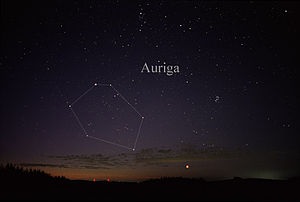
If you see a pentagon of stars in the sky, it is the Auriga constellation. A constellation in the northern hemisphere, Auriga or ‘the Charioteer’ was first documented by the Greek astronomer Ptolemy in the 2nd century. The constellation resembles the shape of a pointed helmet of a charioteer and Auriga in Latin means ‘the Charioteer’. Auriga belongs to the Perseus family of constellations and can be seen in different forms depending on how an individual looks at it. When you connect the stars, it can be viewed as a pentagon of five stars or a kite. Let us learn more Auriga.
The major stars in Auriga are:
- Capella (Alpha Aurigae): Capella is the brightest star in the Auriga and is also the sixth brightest star in the sky. It is about 42.2 light years away. It also consists of two binary pairs of stars; a pair of large, bright G–type giants and a pair of small cool red dwarfs.
- Menkalinan (Beta Aurigae): Menkalinan is a triple star system, about 85 light years away. The two brightest components in the Auriga are white A–type sub–giant stars while the third component is a red dwarf. They have a magnitude that varies between 1.85 and 1.93.
- Mahasim (Theta Aurigae) – Mahasim is basically a double star and is about 173 light years away from the earth. It has an apparent magnitude of 2.65. In this system, the brightest component is basically a white A–type dwarf and its companion is a yellow G–type main sequence dwarf. Theta Aurigae A has a magnitude of 2.7 whereas Theta Aurigae B has a magnitude of about 7.2.
- Kabdhilinan (Hassaleh): Also known as Iota Aurigae, it is known by several traditional names but is commonly termed as Hassaleh. Hassaleh is basically an orange K–type bright giant with a magnitude of about 2.69 and is about 512 light years away.
- Almaaz (Epsilon Aurigae): Almaaz is basically an eclipsing binary star with a diameter of 135 times more than that of the Sun. Its magnitude drops from 2.92 to 3.93 for a period of 66 days in every 27 years. It is around 2,000 light years away.
- Haedus II (Eta Aurigae): Haedus II is basically a blue–white B–type main sequence dwarf, which is about 219 light years away. Haedus II has a magnitude of about 3.18.
- Sadatoni (Zeta Aurigae): This star is commonly termed as Sadatoni and is an eclipsing star situated about 790 light years away from the earth. Sadatoni comprises of a red supergiant and a B8 type companion. Its magnitude varies between 3.61 and 3.99 with a period of about 972 days.
- Prijipati (Delta Aurigae) – Prijipati is a binary star situated about 140 light years from the earth. It comprises of an orange K–type giant and a companion star about 115.4 seconds away. The primary star of Prijipati has a magnitude of 3.72 whereas the companion has a magnitude of 9.7.
- AE Aurigae – AE Aurigae, in comparison with its neighbouring stars moves through space at a high velocity and therefore, is often termed as a runaway star. AE Aurigae is basically a blue O–type main sequence dwarf which has irregular variations in its luminosity. The luminosity of AE Aurigae varies between 5.78 and 6.08.
The other notable stars in this constellation are the Al Hurr (Lambda Aurigae) and y Aurigae (Gamma Aurigae).
Some of the deep sky objects in the constellation include:
- Messier 36 (NGC 1960) – It is an open cluster located in the southern region of Auriga. An Italian astronomer Giovanni Batista Hodierna discovered it in the 17th century which was later re–discovered again by Le Gentil about a century later and was finally re–discovered by Charles Messier in 1764. It comprises of about 60 stars and has a magnitude of 6.3. It is about 4,100 light years away from the earth. The estimated age of Messier 36 is believed to be 25 million years.
- Messier 37 (NGC 2099) – Messier 37 is a bright open cluster discovered by Giovanni Batista Hodierna. It is between 3,600–4,700 light years away from the earth and comprises of 500 stars. Out of these stars, about 150 of them have a magnitude of about 12.5. Messier 37 consist of a dozen of red giants and its age is estimated to be 300 million years.
- Messier 38 (NGC 1912) – Messier 38 is situated about 2.5 degrees to the northwest of Messier 36. It is basically an open cluster approximately 4,200 light years away. The brightest stars in Messier 38 form an oblique cross. The cluster is believed to be 220 million years.
- The Flaming Star Nebula (IC 405) – The Flaming Star Nebula can be seen near the open cluster M38. It basically lies about 1,500 light years away from the earth and has a magnitude of 6.0.
The other notable deep sky object in Auriga is IC 410.
Auriga lies in the first quadrant of the northern hemisphere, and can be seen at latitudes between +90°and -40°.
Auriga is the 21st biggest constellation in the night sky and it occupies about 657 square degrees of space.
Auriga is surrounded by constellations like Camelopardalis, Gemini, Lynx, Perseus and Taurus are the neighboring Constellations of Auriga.

There are many mythological stories associated to Auriga. One of them frequently identifies Auriga with Erichthonius, the king of Athens and son of the fire god Hephaestus. He was raised by the goddess Athena who taught him many skills he would not have ordinarily learned. He became the first man to tame and harness four horses to a chariot which impressed Zeus, who placed him among the stars. Another popular myth says that Auriga represents Hephaestus himself, the lame god who built the chariot so that he could travel anywhere he wanted to without any difficulty.
G Kowledge of | 0 Comments >>
0 Comments
Leave Comment
Your email address will not be published. Required fields are marked.